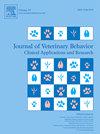Effects of chiropractic manipulations on behavioral and physiological parameters in healthy horses: A preliminary investigation
IF 1.3
3区 农林科学
Q4 BEHAVIORAL SCIENCES
Journal of Veterinary Behavior-clinical Applications and Research
Pub Date : 2024-11-01
DOI:10.1016/j.jveb.2024.10.006
引用次数: 0
Abstract
Human chiropractic is a well-established, evidence-based complementary medicine. Contrariwise, there is a lack of research on its impact on horses. This study aimed to evaluate the effects of chiropractic treatment on healthy horses by measuring behavior, maximum temperature of the eyes (MaxTE), salivary cortisol (SC), and heart rate variability (HRV). Eight mares were selected and exposed to a 15-day habituation period. Then, they were randomly assigned to a grooming (GROOM) or chiropractic (CHIRO) session, performed by the same qualified chiropractor. The experiment was designed as a cross-over study and repeated after a 10-day washout (i.e., Week 1 and Week 2). During-CHIRO, the chiropractor treated and recorded joint hypomobility. During-GROOM, the mares were subjected to a standardized grooming session. MaxTE and SC were obtained before (T0), immediately after (T1), and one day after (T24) both sessions. In addition, before (Pre), during (During), and after (Post) both sessions, the mares were video recorded, and heart rate for HRV analysis was taken. Videos were analyzed using a specific ethogram and a Behavioral Discomfort Score (BDS) was obtained. Results showed that the mares manifested temporary signs of discomfort During-CHIRO, highlighted by an increase of ‘avoidance movements’ (p < 0.001) and ‘alert’ (p = 0.038). This was confirmed by an increase in BDS During-CHIRO (p = 0.044). No sympathetic shift was shown by MaxTE, SC, and HRV. A significant increase in the standard deviation of RR intervals (SDNN) suggested a parasympathetic shift in Post-CHIRO (p = 0.040). Joint hypomobility tended to decrease between the first and second CHIRO (p = 0.09). Our results showed that equine chiropractic could be performed by a qualified veterinary chiropractor, leading to transient discomfort behavior, not accompanied by acute stress response. On the contrary, there seems to be a subsequent relaxation, demonstrated by an autonomic nervous system shift toward the parasympathetic branch. Consequently, chiropractic manipulation could be considered as an integrative treatment to improve the horses’ welfare.
脊椎按摩对健康马匹行为和生理参数的影响:初步调查
人类脊骨神经疗法是一种成熟的、以证据为基础的辅助医学。相反,有关其对马匹影响的研究却很缺乏。本研究旨在通过测量马匹的行为、眼睛最高温度(MaxTE)、唾液皮质醇(SC)和心率变异性(HRV),评估脊骨神经治疗对健康马匹的影响。研究人员挑选了八匹母马,对其进行了为期 15 天的适应性训练。然后,它们被随机分配到由同一位合格的脊椎按摩师进行的美容(GROOM)或脊椎按摩(CHIRO)疗程。实验设计为交叉研究,在 10 天的冲洗期(即第 1 周和第 2 周)后重复进行。在"-CHIRO "期间,脊骨神经科医生治疗并记录关节活动度不足的情况。在 "梳理 "过程中,母马接受标准化梳理。在这两个过程之前(T0)、之后(T1)和之后一天(T24),分别采集了最大TE和SC值。此外,在两个环节之前(前)、期间(中)和之后(后),都对母马进行了录像,并采集了心率变异分析所需的心率。使用特定的心电图对视频进行分析,并得出行为不适评分(BDS)。结果表明,母马在 "中智 "期间表现出暂时的不适迹象,突出表现为 "回避动作"(p < 0.001)和 "警觉"(p = 0.038)的增加。这一点通过 BDS 在 CHIRO 期间的增加得到了证实(p = 0.044)。MaxTE、SC 和 HRV 均未显示交感转移。RR间期标准偏差(SDNN)的明显增加表明在 "CHIRO后 "出现了副交感神经转移(p = 0.040)。在第一次和第二次CHIRO之间,关节活动度降低(p = 0.09)。我们的研究结果表明,合格的兽医脊椎按摩师可以对马进行脊椎按摩,从而导致短暂的不适行为,而不会伴有急性应激反应。相反,自律神经系统向副交感神经分支的转移似乎证明了随后的放松。因此,脊骨神经治疗可被视为一种改善马匹福利的综合疗法。
本文章由计算机程序翻译,如有差异,请以英文原文为准。
求助全文
约1分钟内获得全文
求助全文
来源期刊
CiteScore
3.50
自引率
16.70%
发文量
107
审稿时长
325 days
期刊介绍:
Journal of Veterinary Behavior: Clinical Applications and Research is an international journal that focuses on all aspects of veterinary behavioral medicine, with a particular emphasis on clinical applications and research. Articles cover such topics as basic research involving normal signaling or social behaviors, welfare and/or housing issues, molecular or quantitative genetics, and applied behavioral issues (eg, working dogs) that may have implications for clinical interest or assessment.
JVEB is the official journal of the Australian Veterinary Behaviour Interest Group, the British Veterinary Behaviour Association, Gesellschaft fr Tierverhaltensmedizin und Therapie, the International Working Dog Breeding Association, the Pet Professional Guild, the Association Veterinaire Suisse pour la Medecine Comportementale, and The American Veterinary Society of Animal Behavior.

 求助内容:
求助内容: 应助结果提醒方式:
应助结果提醒方式:


